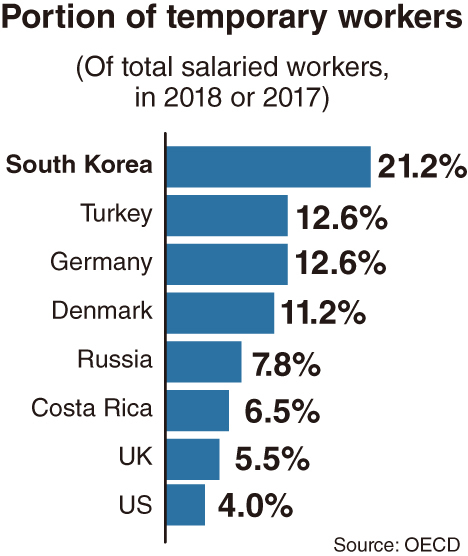SEJONG -- In South Korea, the government does not include people with nonregular jobs -- like temporary or contract employees -- when it counts the official number of jobless. As a result, the nation’s official unemployment rate stayed at 3 percent as of October (the latest figure).
The figure is far from the people’s sentiment toward the hiring market, in which the “extended (or sentiment–reflected)” unemployment rates, compiled by Statistics Korea, have remained above 10 percent in recent years.
The disparity between the official and extended jobless rates could be seen in data held by the Organization for Economic Cooperation and Development, which compared 42 major economies -- comprising 32 of 36 OECD members and 10 nonmembers -- in the percentage of temporary workers as of 2018 or 2017.
Korea saw its proportion of temporary workers, which refers to those whose job has a predetermined termination date, post 21.2 percent of total salaried workers in 2018.
 |
Nonregular employees working at schools stage a rally, demanding conversion of their status into regular employees in front of the headquarters of Busan City Office of Education in Yangjeong-dong, Busan, earlier this year. (Yonhap) |
The figure marked the seventh-highest among portions reported by the 42 countries. This is quite high compared to the average of the 28-member European Union at 14.2 percent, 11.7 percent of the 36-member OECD and 9 percent of the Group of Seven.
While the US (38th) and UK (35th) posted only 4 percent and 5.5 percent, respectively in temporary-job percentage, many emerging economies posted figures lower than that of Korea.
Slovenia (13th) posted 15.9 percent, followed by Turkey (18th) with 12.6 percent, Greece (20th) with 11.3 percent, Czech Republic (27th) at 8.9 percent, Russia (30th) at 7.8 percent, Hungary (32nd) with 7.3 percent and Costa Rica (34th) marking 6.5 percent.
Among countries recording under 5 percent were Bulgaria (37th) at 4.1 percent, Estonia (39th) at 3.5 percent, Latvia (40th) at 2.7 percent, Lithuania (41st) at 1.6 percent and Romania (the lowest among the 42) at 1.1 percent.
Those holding figures under the OECD average included Denmark (21st) with 11.2 percent, Belgium (22nd) with 10.8 percent, Ireland (23rd) with 10 percent, Iceland (25th) with 9.2 percent, Norway (28th) with 8.4 percent and Australia (36th) at 5.3 percent.
Only six marked higher temporary-job portions than Korea. Those were the Netherlands, Portugal, Poland, Spain, Chile and Colombia (the highest of the 42 at 28.8 percent).
 |
(Graphic by Kim Sun-young/The Korea Herald) |
“The OECD comparison indicates the relatively weak job security in Korea,” said an employment research fellow in Seoul. “While the official jobless rate of 3 percent means the number of unemployed were 864,000, the de facto unemployed people has reached 3.17 million of the extended working-age population, 29.95 million.”
According to a recent joint survey by Job Korea and Albamon, 31.4 percent of salaried workers in their 20s and 30s started their economic activities with the status of nonregular workers.
Further, nearly half (48.5 percent) of high school graduates were nonregular workers -- holding temporary or contract jobs -- when they were initially hired. More than 1 in 4 university graduates (27.9 percent) and college graduates (30.1 percent) were in the same situation.
A researcher of the Labor Research Institute of Korea University said “the recent improvement in hiring of the young generation (in their 20s) could be attributable to an increase in part-time or short-term jobs rather than an improvement in stable jobs.”
It is necessary for the government to push for the creation of fundamentally stable jobs, citing the extended unemployment rate, he said.
According to the government’s official unemployment rate, the number of jobless people among those aged 15-29 stood at 309,000 in October.
However, the extended youth jobless rate -- based on the Supplementary Index III for Employment -- came to 20.5 percent for the corresponding month, with the number of unemployed exceeding 1 million.
Meanwhile, Korea has increased the number of people in their late 50s and early 60s working in the public sector as nonregular employees. This has come under criticism for recklessly spending taxpayer-money to artificially lower the official jobless rates.
By Kim Yon-se (
kys@heraldcorp.com)





![[Herald Interview] 'Trump will use tariffs as first line of defense for American manufacturing'](http://res.heraldm.com/phpwas/restmb_idxmake.php?idx=644&simg=/content/image/2024/11/26/20241126050017_0.jpg)

![[Health and care] Getting cancer young: Why cancer isn’t just an older person’s battle](http://res.heraldm.com/phpwas/restmb_idxmake.php?idx=644&simg=/content/image/2024/11/26/20241126050043_0.jpg)

